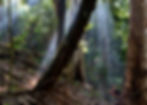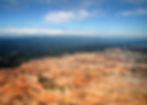Lives on the edge -Indigenous territories as protected areas
- Rich D'Amaru
- Jul 21, 2019
- 4 min read
Updated: Jul 27, 2019
Thiago Cardoso

"The indigenous territories are not unproductive areas, but they are those areas that guarantee that we have rain, wind and preservation of the environment." This phrase, posted via Twitter by Sônia Guajajara, a great indigenous leader in Brazil, represents the vision that indigenous peoples have of their territories. Beyond production and the market, they are places for the promotion of human and non-human life, and must be protected.
Sonia helps us to understand the basic foundation of an "indigenous territory." However, many people are not familiar with the ways in which such territories are recognized and maintained in the current rights systems of Latin American countries, less so about the importance of these areas for environmental and climatic conservation in biomes such as the Amazon and, even less, about the challenges faced by various peoples regarding the threats to their ways of life in their territories.
Each indigenous territory is built according to the way of life of each indigenous peoples, and is generally based on kinship relations, on mobility, the construction of cosmographic knowledge and different relations with the environment. An example would be the way of Yanomami territoriality, based on the articulation between intense and expansive movements between new and old places: a territory as network[1]. Indigenous peoples strive to ensure that the National State recognizes and demarcates their rights for their traditional territories according to their socio-cultural and environmental particularities, without such territories being reduced to the logic of property, of a quantitative knowledge about the world. The articulation between the singular ways of indigenous territoriality and the models of land demarcation foreseen in the Multicultural Constitutions of the Latin American countries is, without a doubt, the main challenge of contemporary indigenous social movements for land rights. What is at stake is the recovery of the survival conditions of the multiplicity of indigenous peoples after the seizure and privatization of lands undertaken during the Portuguese and Spanish colonization, and the aggravation of the territorial loss by the new ways of agribusiness and neo-extravism.
Indigenous land rights are the collective rights of indigenous peoples to land. Land and cultural and environmental-related rights are of fundamental importance to indigenous peoples for a range of reasons, including: the cosmological significance of the land, self-determination, identity, and economic factors. According to the Raisg (Amazon Geo-Referenced Socio-Environmental Information Network), indigenous territories occupy more than 45% of the Amazon Biome and represent the most preserved area in Brazil, Colombia, Venezuela, Peru, Ecuador, Bolivia, Suriname and Guyana's, where 1.5 million persons from 385 different ethnic groups live in cities and demarcated lands.

In Brazil, an indigenous land is an inhabited area and exclusively possessed by indigenous peoples. The Brazilian Constitution recognizes the inalienable rights of indigenous peoples to lands traditionally occupied and automatically confers them with permanent possession of these area. As of 2016, there are 672 indigenous lands in Brazil, covering 13% of the country. The majority of indigenous land is concentrated in the Amazon, which corresponds to more than 20% of the area of the Brazilian Amazon.
In other countries such as Peru, which has one of the largest indigenous population in Latin America and the Caribbean, indigenous people are organized in 1509 Native Communities, whose lands added together represent an area of 14% of the Peruvian Amazon Region. At the same time, there are 5 Territorial Reserves for Indigenous Peoples in Voluntary Isolation and the figure of the Communal Reserves for indigenous or non-indigenous local populations, which forms part of the National System of Natural Areas Protected by the State. In Colombia, 31.5% of the country is entitled as territories (resguardos) of the 87 indigenous peoples that inhabit the Andes or the Savannas and Amazon Forests. In the Amazon area there are 156 resguardos that make up 64% of the total land in the Colombian Amazon. In Ecuador, indigenous peoples demand as their own territories an area of 6,308,000 hectares, equivalent to 25% of the national territory and 64% of the Ecuadorian Amazon, being that half of this size is entitled as protected areas. All other South American countries have their own models of land recognition and demarcation for indigenous peoples, following national laws and global agreements.
The history of demarcation of these territories forms a mosaic of protected areas in the Amazon, fundamental for the global biocultural diversity. Even after demarcation, territories are frequently threatened by national companies and transnational corporations that connect the region to global capitalism, making the Amazon a producer of raw materials and food. Deforestation, degradation and loss of carbon threaten the territories of the various indigenous, extractivist and river side communities (ribeirinhos) as well as species of animals and vegetables of all sizes and beauty. In addition to this, it accentuates the climate crisis that affects the entire planet.
Indigenous peoples coexist and fight in various local, national and international arenas against the implantation of infrastructure in their territories, such as the Indigenous Territory and Isiboro Sécure National Park (TIPNIS), in Bolivia. In Brazil, Munduruku, Juruna and Kayapó fight against mega-hydroelectric plants in their rivers. Another fighting front is the "oil war" that mobilizes indigenous people from the province of Pastaza in Ecuador and threatens several "isolated" peoples located in the "Intangible Zone" of the Yasuní National Park, one of the most biodiverse places in the world. Also in Ecuador, the Shuar seek to recover and protect their territory against Chinese miners protected by the military. Illegal mining is also epidemic in the Brazilian Amazon, affecting many peoples, such as the Yanomami, victims of the "gold rush", which has the support of local politicians.
As I wrote elsewhere, in this journal, we can consider indigenous territories as protected areas, because they protect indigenous peoples, their environments and sacred places, and at the same time protect our planet from the insatiable extractive and predatory behavior of companies and governments. It is in the Amazonian indigenous territories that we find most of the biodiversity, agrobiodiversity, quality water and pulsating forests, constantly produced, reproduced and cared for with parsimony.
We must listen to the voices of leaders and thinkers of indigenous peoples, such as Sonia Guajajara, when they say that their indigenous territories are protected areas, which are alive and for life. What they say point us to other ways of existence, to alternative worlds to that of the hecatomb of a time in which catastrophes, genocide and devastated landscapes are considered a necessary evil for the production of wealth – with one detail- for few people.
[1] Albert, Bruce, and François-Michel Le Tourneau. "Ethnogeography and resource use among the Yanomami: Toward a model of “reticular space”." Current anthropology 48.4 (2007): 584-592.
